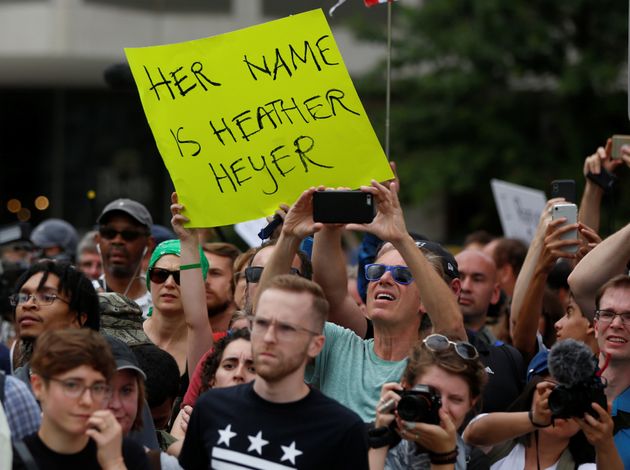
On Sunday 12 August, chaos was supposed to descend on Washington DC. Nazis, Klansmen, and other assorted white supremacists planned a “Unite the Right” rally in the nation’s capital to mark the one-year anniversary of the Charlottesville rally. The same rally where counter-protestor Heather Heyer was killed by white supremacists driving a van into a crowd.
Sunday 12 August also marked the one-weekaversary of my arrival in DC and the United States. I thought I was prepared for the political climate awaiting me, but I had no defence for how hard the blatant displays of hate and institutionalised injustice that characterise large parts of the capital’s landscape would hit me. Now with added Nazis! There was no doubt in my mind: I had to show up for the counter.
“Oh my god, don’t go!” said everyone at my workplace, warning me about the likelihood of things getting out of control. My mum was less than pleased. I, along with most in the city, expected the worst. I did what I could to prepare myself and find ways to stay safe.
I ended up following the over 2000 people who showed up to Lafayette Square all the way to the fence, where a heavy police presence kept up a sizeable buffer zone between the white supremacists and the counter-protestors. Members of Antifa marched first, many in full riot gear.
All this, only for a puny turnout of two dozen far-right demonstrators, quickly limping back out of town with their tails between their legs and rain over their heads before their rally was even scheduled to start.
The #ShutItDownDC movement had successfully and spectacularly shut down what could have been a terrifying display of the power of hate groups in this country. It’s certainly cause for celebration – but what conclusions can we draw from this outcome?
Though I wish this was not the case, the most important takeaway from the failed Unite the Right rally is not that hate groups are now significantly weakened in the US. They are simply gearing for a change in strategy. While rally organiser Jason Kessler and the like have admitted that on-the-streets rallies are failing, they have stated that it is now time to focus on online activities, where the “alt-right” movement has seen great success. They now favour promoting other, more mainstream right-wing positions as a front for white supremacy.
This is made possible by the fact that “alt-right” rhetoric is currently enjoying a moment in the mainstream. These hate groups are greatly enabled by Donald Trump’s presidency – white supremacist leaders such as Richard Spencer openly admit this. In 2017, there were a total of 1,038 hate crimes recorded in the 10 largest American cities last year, an increase of 12 per cent from 2016 and the highest figure in more than a decade. The day before the rally, I saw groups wearing red Make America Great Again caps gathered outside the Holocaust Memorial Museum. Expressions of hate that should cause outrage pass unnoticed and unopposed every day.
Let us not forget that DC spent at least $2.6million (£2m) to essentially give space to and protect the Unite the Right rally, through law enforcement, road and metro stop closures, cleanup, and other measures. That is over $100,000 (£78,000) per far-right supporter that actually showed up, that can be considered as red-carpet treatment. While efforts to keep the situation from escalating were certainly needed after last year’s events in Charlottesville, how in the world did we end up in a situation where this is normal?
Ahead of the rally, Facebook deleted the main event page for the counter-protest, and effectively removed the main public tool of mobilising people who wanted to resist hate. Let’s acknowledge this is the environment that organisers opposing the far-right have to operate in.
This makes the fact that thousands of people showed up for the counter-protest even more amazing. This was not an inevitability. This was the result of months and months of dedicated planning and community mobilisation, through a coalition of grassroots organisations such as Black Lives Matter, Resist This, The Future Is Feminist, Occupy, and yes, the Antifa/Abolitionist bloc. The protest proceeding without incident is a testament to the quality of local organising work by these groups.
The rally could also not have been shut down if it had not been made clear that the white supremacists would be vastly outnumbered by people opposing their message of hate. There was no need to escalate the situation – numbers bring protection in themselves.
Yet, many of the people I spoke to ahead of the rally seemed to be under the impression that showing up to the counter-protest was the business of “radicals”. Best to keep your head down, they said, stay out of the city, things will get ugly. While it is natural to be afraid of a group that has such a prolific history of violence (I certainly was), the attitude that opposing this violence is not the moral duty of every citizen toward your fellow human beings was my greatest culture shock. If you believe that opposing Nazis is too radical a position, take a long, hard look in the mirror.
Let’s celebrate this victory, but let’s not be complacent. Let’s shut down hate wherever it rears its ugly head. That means collective organising and relentless resistance, online and offline, in the US and elsewhere in the world. I will continue to show up, and I hope you will too.